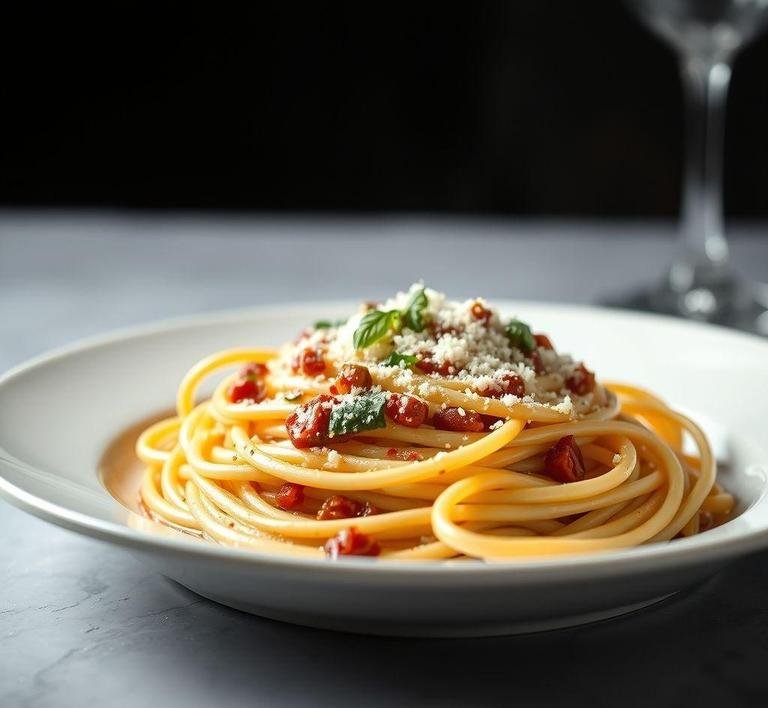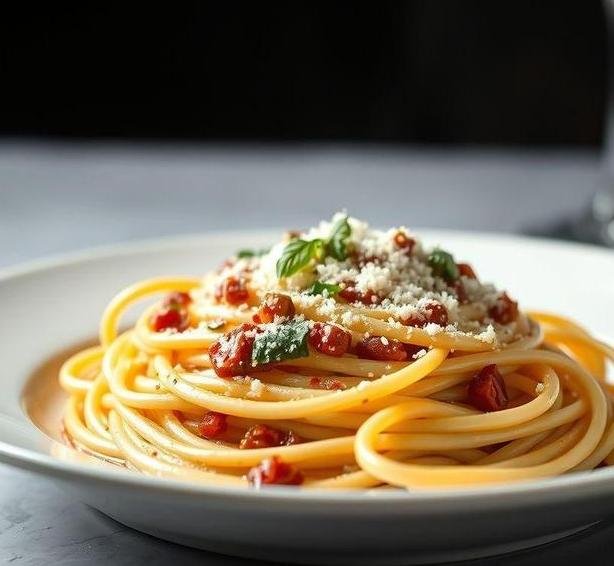Mary Berry’s Spaghetti Carbonara is her take on the traditional Italian dish, with a British twist that makes it approachable for home cooks without sacrificing authentic flavor. Carbonara, known for its creamy texture and savory, slightly smoky taste, typically relies on eggs, cheese, guanciale (or pancetta), and pepper to create a luxurious sauce. Mary Berry’s version simplifies some of the more challenging aspects of the dish, offering a recipe that is rich yet still light, with a more accessible approach to the ingredients and cooking process.
In her recipe, Berry maintains the essential elements of carbonara – eggs and cheese as the base for the sauce – but she opts for bacon (a common substitution in British kitchens) instead of the traditional guanciale, making it more widely available without sacrificing the depth of flavor. Her approach is designed to bring the comforting flavors of carbonara to the home kitchen, ensuring that even novice cooks can recreate it with ease. The result is a creamy, comforting pasta dish with a depth of flavor that delights the taste buds, making it perfect for a family dinner or even a quick yet sophisticated meal for guests.
Mary Berry’s Spaghetti Carbonara Recipe
Ingredients Needed

To make Mary Berry’s Spaghetti Carbonara, you’ll need the following ingredients:
- Spaghetti (400g) – The heart of the dish, spaghetti provides the perfect structure for the rich sauce to cling to. You can substitute with other pasta types like linguine or fettuccine, but spaghetti is the traditional choice.
- Bacon (200g) – Mary Berry uses streaky bacon here, which adds a crispy, salty element to the dish. You can also use pancetta if you prefer, but bacon will give you a deeper, smokier flavor.
- Eggs (2 large) – These will form the base of the creamy carbonara sauce. The key to making the sauce silky is to toss the hot pasta with the eggs quickly to create a smooth, rich texture without scrambling them.
- Parmesan cheese (50g) – Freshly grated Parmesan is essential to achieving the full flavor profile. It adds a sharp, nutty richness to the dish. You could also use Pecorino Romano for a more intense flavor.
- Heavy cream (100ml) – While not a traditional ingredient in classic Italian carbonara, Mary Berry adds cream for a slightly softer texture. This makes the sauce more forgiving and creamy, without the need for precise timing to avoid the eggs scrambling.
- Garlic (1 clove) – A small but crucial addition, garlic provides a subtle aromatic depth, complementing the bacon’s smokiness.
- Black pepper – Freshly ground, black pepper adds a sharp, spicy bite that enhances the richness of the eggs and cheese, giving the dish its signature kick.
- Olive oil (for frying) – Used to fry the bacon and garlic, olive oil imparts a touch of Mediterranean flavor and ensures the bacon crisps up beautifully.
Equipment Needed
While the recipe is simple, a few key pieces of kitchen equipment will make it much easier to prepare Mary Berry’s Spaghetti Carbonara.
- Large pot – This is essential for boiling the spaghetti. Make sure it’s big enough to allow the pasta to move freely and cook evenly.
- Frying pan – You’ll need a large frying pan to fry the bacon and garlic. This is where you’ll cook the bacon until it’s crispy and where you’ll combine the pasta with the creamy sauce.
- Colander – To drain the pasta once it’s cooked, ensuring that excess water doesn’t dilute your sauce.
- Wooden spoon or tongs – You’ll need this to toss the spaghetti in the pan with the eggs and cheese mixture, ensuring that everything is evenly coated.
- Grater – For fresh Parmesan (or Pecorino), a fine grater works best to get that delicate, melt-in-your-mouth texture when the cheese is added to the sauce.
- Whisk – A small whisk is handy to beat the eggs and cream together to make the base of the sauce. It ensures that the eggs break up evenly and combine smoothly with the cream.
- Large mixing bowl – To whisk together the eggs, cream, and grated cheese before adding them to the hot pasta.
Instructions To Make Mary Berry’s Spaghetti Carbonara
- Prepare the pasta: Begin by bringing a large pot of salted water to a boil. Add the spaghetti and cook according to the package instructions until al dente (usually around 8-10 minutes). Once cooked, reserve a cup of pasta water, then drain the spaghetti in a colander.
- Cook the bacon: While the pasta is cooking, heat a frying pan over medium heat and add a splash of olive oil. Once hot, add the bacon and cook it until crispy and golden brown, which should take about 4-5 minutes. Once the bacon is done, remove it from the pan and set it aside.
- Infuse the garlic: In the same pan, add the minced garlic and sauté for 1-2 minutes until fragrant. Be careful not to burn the garlic, as it will turn bitter.
- Make the egg mixture: In a large mixing bowl, whisk together the eggs, cream, and grated Parmesan cheese until smooth. Season generously with freshly ground black pepper. You can also add a pinch of salt, but be cautious since the bacon and cheese will already provide a lot of saltiness.
- Combine the pasta and sauce: Add the hot, drained spaghetti to the frying pan with the garlic. Toss the pasta well to coat in the bacon fat and garlic. Quickly pour the egg and cream mixture over the pasta while it’s still hot. Toss vigorously using tongs or a wooden spoon. The heat of the pasta will cook the eggs just enough to create a silky, creamy sauce. If the sauce looks too thick, add a bit of the reserved pasta water to loosen it up.
- Finish with bacon and cheese: Chop the crispy bacon into bite-sized pieces and toss it into the pasta. Serve the carbonara immediately, with a generous sprinkle of extra grated Parmesan and a final crack of black pepper.
Tips And Tricks
- Use pasta water to adjust the sauce: The reserved pasta water is key to perfecting the carbonara sauce. If the sauce becomes too thick, add a small amount of the pasta water and toss until you get the desired consistency.
- Don’t overcook the eggs: When tossing the pasta with the egg mixture, make sure you’re doing it off the heat or over very low heat. The goal is to gently cook the eggs, creating a creamy sauce. If you cook the eggs too long, they’ll scramble and the sauce will become lumpy.
- Grate your own cheese: Pre-grated cheese often has anti-caking agents that can affect the smoothness of the sauce. Grating fresh Parmesan or Pecorino yourself ensures a smoother, more flavorful sauce.
- Keep the bacon crispy: Bacon can lose its crispiness quickly once it’s mixed with the sauce. To keep it crunchy, toss it in at the very last minute, just before serving, so it retains its texture.
- Creamy but not too heavy: Mary Berry’s addition of cream makes the dish creamy without making it overly heavy. If you prefer a lighter version, you can reduce the amount of cream or leave it out entirely, relying on just eggs for the sauce.
Mary Berry’s Spaghetti Carbonara offers a delightful and accessible take on an Italian classic. With her thoughtful approach to ingredients and cooking technique, she’s created a recipe that allows home cooks to achieve a creamy, flavorful carbonara without the need for complex techniques or hard-to-find ingredients. By using bacon, eggs, and Parmesan, along with a touch of cream, she strikes a perfect balance between richness and comfort. Whether you’re making it for a busy weeknight dinner or a more special occasion, this recipe delivers delicious results every time. Follow the steps, keep the tips in mind, and you’ll have a beautiful bowl of carbonara that’s sure to impress!
Easy Recipe Variations For Mary Berry’s Spaghetti Carbonara

Mary Berry’s Spaghetti Carbonara is a classic, creamy, and indulgent dish that strikes a perfect balance between richness and comfort. While her version of the recipe offers a timeless take on the traditional, there are plenty of easy variations to personalize it according to your taste, dietary preferences, or the ingredients you have on hand. Here are some creative tweaks to elevate your Carbonara:
1. Vegetarian Carbonara
For those who prefer a plant-based meal, a vegetarian Carbonara is a fantastic option. The key is to substitute the traditional pancetta or guanciale with vegetables that offer both texture and flavor. Mushrooms-especially shiitake, cremini, or portobello-work well because of their umami-rich depth. Simply sauté them until they are golden and slightly crispy, and then toss them through the pasta as you would with the meat. Adding a handful of spinach or kale can also bring a burst of color and nutrition to the dish. To replace the eggs, use a plant-based cream or a combination of silken tofu and nutritional yeast for that creamy texture and savory flavor.
2. Chicken Carbonara
If you’re craving some protein but not keen on using pork, chicken is an excellent substitute. Grilled or pan-fried chicken breast works wonderfully in a Carbonara dish. You can dice it into small pieces, sauté it with garlic and olive oil until golden, and then toss it into your cooked pasta with the creamy sauce. To enhance the flavor, consider adding a touch of lemon zest or herbs like thyme or rosemary.
3. Smoked Salmon Carbonara
For a luxurious twist, smoked salmon can replace the pancetta or bacon, offering a delicate smoky flavor that pairs perfectly with the creamy sauce. This variation is particularly lovely if you’re making Carbonara for a special occasion. You can cut the smoked salmon into strips or small pieces and gently toss it through the pasta after it’s been coated with the egg and cream mixture. For a further upgrade, top with a few fresh dill sprigs or capers for added contrast.
4. Carbonara with Peas and Asparagus
Incorporating vegetables not only makes the dish more colorful but also introduces a fresh contrast to the rich sauce. Sweet peas and tender asparagus are wonderful additions, bringing a slight crunch and a natural sweetness that balances the saltiness of the bacon or pancetta. Blanch the asparagus in boiling water and sauté the peas briefly before tossing them with the pasta and sauce.
5. Spicy Carbonara
If you’re a fan of heat, why not add a little spice to your Carbonara? A pinch of red chili flakes or a dash of smoked paprika can add a warming kick to the dish. If you like it extra fiery, consider adding some finely chopped fresh chili to the pancetta as it crisps up. This variation gives a wonderful contrast to the richness of the sauce, adding a layer of complexity without overwhelming the dish.
6. Gluten-Free Carbonara
For those following a gluten-free diet, simply swap out regular spaghetti for gluten-free pasta. These days, gluten-free pasta options, including rice-based or chickpea pasta, are available in a variety of shapes and textures that work well in carbonara. Just be sure to follow the cooking instructions carefully, as gluten-free pasta tends to cook a little differently.
Storing Leftovers
While Mary Berry’s Spaghetti Carbonara is often best enjoyed fresh, leftovers can be a wonderful treat if stored properly. To ensure that your leftover Carbonara stays as delicious as possible, follow these guidelines:
1. Cool It Quickly
When storing leftovers, the first thing to do is allow the dish to cool down to room temperature. This helps prevent bacterial growth. To cool it faster, you can spread the pasta out on a baking sheet or shallow dish, which will help it cool more evenly.
2. Use an Airtight Container
Once the pasta has cooled, transfer it to an airtight container. This helps to retain the pasta’s moisture while preventing it from absorbing any other odors from your fridge. If you have a large portion, it might be best to divide it into smaller, meal-sized containers for easy reheating.
3. Refrigeration
Store your leftover Carbonara in the refrigerator for up to 2 days. Beyond that, the texture may suffer, and the pasta may become soggy, as the sauce absorbs into the noodles. It’s best to enjoy it within this 48-hour window for optimal freshness.
4. Reheating Tips
Reheating Carbonara can be tricky because the creamy sauce may separate or become too thick. The best method is to gently reheat it in a saucepan over low heat, adding a splash of milk or cream to restore the creamy texture. Stir constantly to ensure it heats evenly without becoming clumpy. Alternatively, you can microwave it, but be sure to do so in short bursts of 30 seconds, stirring between each interval to avoid overheating.
5. Freezing
While it’s not ideal, you can freeze Carbonara if you need to store it for a longer period. However, the creaminess of the sauce might suffer after freezing and thawing. To freeze, transfer the pasta to an airtight container or a freezer bag, making sure to press out any excess air. When you’re ready to enjoy it, thaw it overnight in the fridge and reheat as described above, adding a little cream to help the sauce regain its texture.
What To Eat With Mary Berry’s Spaghetti Carbonara?
Mary Berry’s Spaghetti Carbonara is a rich and filling dish, so pairing it with the right sides can turn the meal into a well-rounded feast. You want something that complements the creamy pasta but doesn’t overshadow its delicate flavors. Here are a few great ideas for sides that work beautifully with Carbonara:
1. Garlic Bread
A classic pairing for any pasta dish, garlic bread is a must-try with Carbonara. The crunchy, buttery bread with garlic complements the creamy texture of the spaghetti perfectly. You can even add a sprinkle of Parmesan on top before toasting it for an extra cheesy bite.
2. Fresh Green Salad
A crisp salad provides the perfect contrast to the richness of the Carbonara. Opt for something light and refreshing like a simple mixed greens salad with a lemon vinaigrette. The acidity from the lemon will cut through the creaminess of the pasta and provide a refreshing bite.
3. Roasted Vegetables
For a slightly more substantial side, roasted vegetables are an excellent choice. Caramelized carrots, roasted bell peppers, and even zucchini make a great accompaniment to the pasta. Their natural sweetness and charred flavor will balance out the richness of the Carbonara.
4. Steamed Asparagus or Broccoli
If you want to keep the meal fresh and light, steamed asparagus or broccoli is a great addition. Both vegetables have a slight bitterness that contrasts nicely with the creamy sauce. Plus, they’re nutritious and easy to prepare!
5. A Glass of White Wine
Pair your Spaghetti Carbonara with a glass of white wine like a crisp Sauvignon Blanc or a light Chardonnay. These wines will enhance the flavors of the dish without overpowering it. If you prefer a non-alcoholic option, a sparkling water with a slice of lemon can offer a refreshing balance.
Conclusion
Mary Berry’s Spaghetti Carbonara is a truly iconic dish, known for its creamy richness and satisfying depth of flavor. Whether you stick to the classic recipe or try out one of the many variations, this pasta dish is versatile and can easily be tailored to suit different tastes. Adding vegetables, swapping proteins, or making it lighter or spicier are just some of the ways you can give this dish your own personal twist. And with the right storage and reheating methods, leftovers can be just as delightful the next day. Pairing your Carbonara with fresh sides and a good drink can elevate the whole meal, turning it into an indulgent yet balanced feast.
FAQs
What Are The Main Ingredients In Mary Berry’s Spaghetti Carbonara Recipe?
Mary Berry’s spaghetti carbonara recipe uses simple yet classic ingredients. The main ones include spaghetti, eggs, grated Parmesan cheese, pancetta (or bacon), garlic, and olive oil. The eggs and cheese combine to form a creamy sauce, while the pancetta or bacon adds a savory, crispy texture to the dish.
Can I Make Mary Berry’s Spaghetti Carbonara Recipe Without Using Cream?
Yes, Mary Berry’s spaghetti carbonara recipe does not include cream, which is a departure from some modern versions of the dish. Instead, the creamy texture comes from the combination of eggs and Parmesan cheese, which, when mixed with the hot pasta, creates a rich sauce without the need for cream.
What Tips Can Help Prevent The Eggs From Scrambling In Mary Berry’s Spaghetti Carbonara Recipe?
To avoid scrambling the eggs in Mary Berry’s spaghetti carbonara, make sure to remove the pasta from the heat before adding the egg mixture. The residual heat from the pasta is enough to cook the eggs and form a creamy sauce. Stir continuously and quickly to ensure the eggs are evenly distributed and create a smooth texture.


